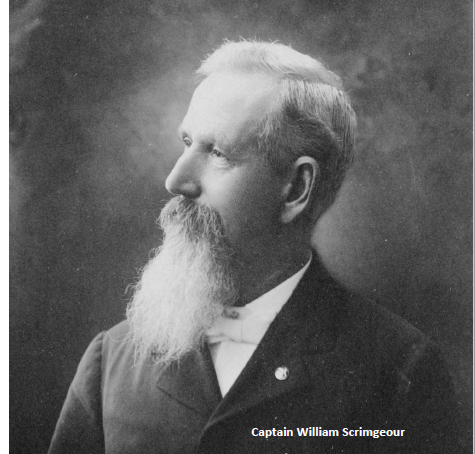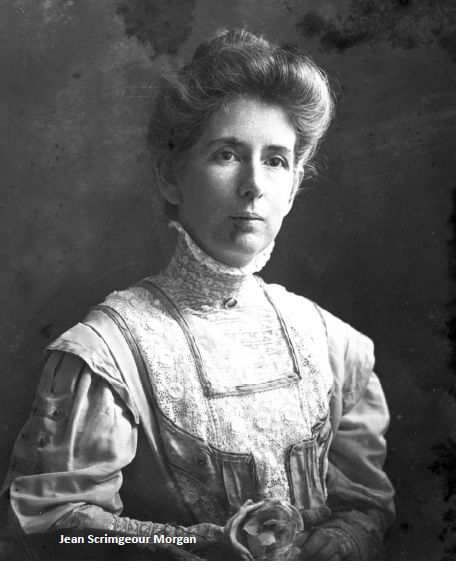As Galveston’s hospital district grew in its early days, it inevitably swallowed up formerly residential lots, including some of the island’s first homes. One such home was the Scrimgeour Morgan residence at 810 Postoffice in the East End, where Shriner’s Hospital now stands. It was built by one of Galveston’s early prominent citizens, Captain William Scrimgeour (1836-1919).
A New York native, Scrimgeour ran away from school at an early age to find adventure at sea. Within a few years, he became a prominent shipping figure in San Francisco during the Gold Rush, and he later joined the United States Revenue Cutter Service sailing from Hong Kong to Shanghai and London. He completed three trips around the world, two by way of Cape Horn.
The well-traveled captain moved to the port city of Galveston in 1857. In July 1864, he married Baltimore-native Josephine Mason (1837-1914) in Lynchburg, Texas, where her father had moved his family to pursue farming.
The couple returned to Galveston where Scrimgeour served as a lieutenant on the Confederate gunboat General Rusk. He then took command of the blockade runner Alice, which cruised between Galveston, New Orleans, Key West, and Havana.
Later in 1864, while in route back to Galveston aboard the Alice, Scrimgeour was captured by federal officials and taken as a prisoner of war to Fort Warren on Georges Island in the Boston Harbor. He remained there for 18 months until a prisoner exchange was arranged.
After the war, he rejoined his bride and they began their family, which included Charles Mason Scrimgeour (1866-1941), Jean Coventree Scrimgeour (1868-1938), and William Robin Scrimgeour (1873-1930). They also lost an infant, whose grave in Galveston’s Trinity Episcopal Cemetery is marked simply with the word “baby.”
Scrimgeour earned a good wage working for the Morgan Lines as a bar pilot, which enabled him to construct an impressive home for his family on one-and-a-half lots on Avenue E (Postoffice).
The two-story frame home had ample room for his growing family with a total of eleven rooms, including five bedrooms, three baths, a living room, kitchen with breakfast area, front parlor, dining room, three brick fireplaces, an octagonal tower, and a large basement.
The rambling lines of the exterior were accented with fish scale detailing and wood siding with tall, narrow windows all around. The south facing front porch on the first-floor featured ball and spindle fretwork along the ceiling.
A second-floor porch extended over the front entryway with an interesting post and cove railing, providing a comfortable outdoor space to sit and enjoy gulf breezes. Pointed gables of the roof rose above a wrought iron fenced garden filled with palms and one plum tree in the front yard.
There was plenty of space in the large backyard for the children to run and play between the home and the large cistern and carriage house, and Josephine oversaw the planting of seasonal flowers in raised beds. It was an ideal spot to grow up, and a popular place for friends and family to visit.
Scrimgeour held a place of respect in the community, and took his duty to protect it seriously. Heedless of his own health, he personally nursed scores of citizens during the 1867 yellow fever epidemic. He continued his work as a bar pilot for 30 years, and also served as harbormaster, supervising the docking of all vessels entering Galveston.
Insurance records note that the Scrimgeour home was “rebuilt” in 1884, adding at least five rooms and a separate wash house in the yard.
An accomplished young woman, the captain’s daughter Jean was a graduate of Galveston Female Institute, a leading school for young ladies on the island during the 1880s. She then enrolled at the Art Students League of New York, an innovative school which attracted many men and women who went on to become internationally famous artists.
After completing her training on the east coast, she returned to Galveston and, in 1890, married George Dickinson Morgan (1862-1942). Their only child, William Manning Morgan (1891-1957) was born the following year.
Despite the addition of her new responsibilities, Jean continued to paint and pursue her studies with local instructor Maria Cage Kimball. Her painting of her own bedroom in the Scrimgeour home is part of the collection of the Rosenberg Library Museum.
Jean’s brothers soon married, as well. William Robin married Edith Davis (1872-1953) in 1895, and Charles Mason Scrimgeour married Mary English Jones (1866-1943) in 1896. Charles moved into his in-law’s home on Avenue H, but his two siblings and their new spouses remained in their childhood home, starting families of their own.
 With three generations living within the walls at certain times, the house was filled with “Williams.” The patriarch had named one of his sons after himself, and two of his children had sons who were also named William.
With three generations living within the walls at certain times, the house was filled with “Williams.” The patriarch had named one of his sons after himself, and two of his children had sons who were also named William.
When the 1900 Storm struck Galveston, William Sr. and his wife Josephine lived in the home along with their daughter Jean and her husband George, Jean’s son William Manning, the captain’s son William Robin and his wife Edith, and their son William Boyer. The household also included live-in servants Fanny Crumes, their 37-year-old cook, and her husband James.
Although the home surely sustained some damage, there is no record of how extensive it was, and no trace of repairs is mentioned in the home’s insurance papers, though it was noted to have been raised during the island’s grade raising.
Jean was so profoundly affected by the aftermath of the catastrophic storm that she redirected her energy away from art and toward community service. She helped to create the Women’s Health Protective Association, which, among other things, cleared storm debris, reburied victims, replanted lost trees, and campaigned to improve the city’s sanitation.
She also became active with the Galveston Chapter of the American Red Cross, the Texas Anti-Tuberculosis Association, and she was instrumental in establishing clinics on both ends of the island where low-income women could receive proper pre- and post-natal care for themselves and their babies.
Having three wage earners in the Scrimgeour-Morgan home afforded the extended family the luxury of hiring a housekeeper, cook, gardener and a few occasional laborers to do any heavy work required to maintain the residence. The ladies of the home took care of the children and tended to social obligations and get-togethers like meetings of the Ladies’ Musical Club.
 By 1910, the elder Scrimgeour had retired, and Jean’s husband George, a retail grocer, took over as head of the household, where they lived with Jean’s parents and two female live-in servants.
By 1910, the elder Scrimgeour had retired, and Jean’s husband George, a retail grocer, took over as head of the household, where they lived with Jean’s parents and two female live-in servants.
In 1911, Jean was elected to the board of female managers of the Galveston Orphan’s Home, and two years later the Galveston Daily News reported that "No one woman, perhaps, in the city of Galveston, has done more toward making the community a better and more pleasing sight to the eye than has Mrs. Morgan."
Josephine, the matriarch of the family, died in April 1914, and her funeral was held at the family residence. Her husband William, a 33rd degree mason, also passed away at home in January 1919, at the age of 83.
Jean, her husband and son remained in the home after her parents’ deaths, but soon admitted it was too large for the three of them.
In 1924, the Scrimgeour home was listed for sale, boasting 16 rooms, a two-car garage, and being “modern in every respect.” But the economy was not favorable for many to afford such an impressive residence, and no buyer was found.
William Robin passed away in 1930, and his sister Jean followed him in 1938. George Morgan remained in the home, and William Boyer (the captain’s grandson) also moved into the residence with his family.
Spare rooms were rented out to boarders to help with expenses. The Great Depression was in full swing, making it a financial challenge to provide necessary upkeep for the home.
William Manning Morgan, Jean’s son, signed over his portion of ownership of the estate to his cousin William Boyer in September 1942, after George’s death, noting on the documents that he had been paid “with love and affection.” The cost of maintaining the grand house was still a struggle, however, and the family listed it for sale once again in July 1945.
When they were unable to find a buyer, they made the decision to sell off much of the contents of the home in a “cash and carry” sale the following September. Included in the sale were family heirlooms of furniture, antiques, pewter, china, brass, and silverware.
William Manning and his wife Jessie continued to raise their two children in the home, and hosted regular gatherings of the Galveston Musical Club members.
Jessie passed away in 1955, and both of the couple’s children had married and moved away in previous years. Finding the spacious house too large to live in alone, William Boyer Scrimgeour sold it out of the family for the first time in 1958.
The new owners were William Armstrong Birdsong (1917-2009) and his wife Barbara (1923-2002), who was a member of the socially prominent Wilkens family of Galveston. She was pregnant with their fifth child, John Randolph, at the time. He unfortunately passed away just two days after his birth.
The schedules of the couple and their four children, Barbara, William Jr., Margaret, and Lucian kept the house filled with activity. Their youngest child, Nancy, arrived in 1960. Mrs. Birdsong’s mother, Margaret Minor Wilkens (1886-1974) also utilized the Birdsong home for gatherings for her social circle, such as meetings of the Daughters of the Republic of Texas in the early-1960s.
After living in the home for just five years, the Birdsongs sold the property to Victoria Anna Napoli who purchased it for use as her home and a boarding house. She maintained the master bedroom and one bathroom for her private use, and rented out the others, offering the option of included meals to her boarders. Her widowed mother Mary lived with Victoria in the home until she passed away in 1969.
In the years that had passed since the home was built, the surrounding area had developed into a medical community and the location of the nearby hospital made the lot the structure stood upon more valuable than the residence itself. Napoli sold the Scrimgeour-Morgan House to an orthopedic clinic in April 1971, and the business demolished the historic home the following month to make way for a new building.
No trace remains of the residence of the family who volunteered for the betterment of the community for two generations.